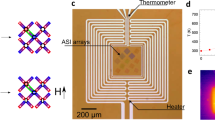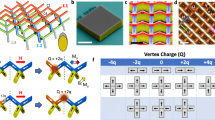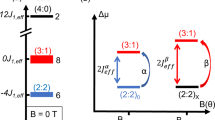Abstract
The transport of electrically charged quasiparticles (based on electrons or ions) plays a pivotal role in modern technology as well as in determining the essential functions of biological organisms. In contrast, the transport of magnetic charges has barely been explored experimentally, mainly because magnetic charges, in contrast to electric ones, are generally considered at best to be convenient macroscopic parameters1,2, rather than well-defined quasiparticles. However, it was recently proposed that magnetic charges can exist in certain materials in the form of emergent excitations that manifest like point charges, or magnetic monopoles3. Here we address the question of whether such magnetic charges and their associated currents—‘magnetricity’—can be measured directly in experiment, without recourse to any material-specific theory. By mapping the problem onto Onsager's theory of electrolytes4, we show that this is indeed possible, and devise an appropriate method for the measurement of magnetic charges and their dynamics. Using muon spin rotation as a suitable local probe, we apply the method to a real material, the ‘spin ice’ Dy2Ti2O7 (refs 5–8). Our experimental measurements prove that magnetic charges exist in this material, interact via a Coulomb potential, and have measurable currents. We further characterize deviations from Ohm's law, and determine the elementary unit of magnetic charge to be 5 μB Å-1, which is equal to that recently predicted using the microscopic theory of spin ice3. Our measurement of magnetic charge and magnetic current establishes an instance of a perfect symmetry between electricity and magnetism.
This is a preview of subscription content, access via your institution
Access options
Subscribe to this journal
Receive 51 print issues and online access
$199.00 per year
only $3.90 per issue
Buy this article
- Purchase on Springer Link
- Instant access to full article PDF
Prices may be subject to local taxes which are calculated during checkout




 in Dy2Ti2O7.
in Dy2Ti2O7. 
Similar content being viewed by others
References
Morrish, A. H. The Physical Principles of Magnetism (Wiley and Sons, 1965)
Jackson, J. D. Classical Electrodynamics (Wiley and Sons, 1998)
Castelnovo, C., Moessner, R. & Sondhi, S. L. Magnetic monopoles in spin ice. Nature 451, 42–45 (2007)
Onsager, L. Deviations from Ohm's law in weak electrolytes. J. Chem. Phys. 2, 599–615 (1934)
Harris, M. J., Bramwell, S. T., McMorrow, D. F., Zeiske, T. & Godfrey, K. W. Geometrical frustration in the ferromagnetic pyrochlore Ho2Ti2O7 . Phys. Rev. Lett. 79, 2554–2557 (1997)
Ramirez, A. P., Hayashi, A., Cava, R. J., Siddharthan, R. B. & Shastry, S. Zero-point entropy in spin ice. Nature 399, 333–336 (1999)
Bramwell, S. T. & Gingras, M. J. P. Spin ice state in frustrated magnetic pyrochlore materials. Science 294, 1495–1501 (2001)
Snyder, J. et al. Low-temperature spin freezing in the Dy2Ti2O7 spin ice. Phys. Rev. B 69, 064414 (2004)
Lee, S.-H. et al. Emergent excitations in a geometrically frustrated magnet. Nature 418, 856–858 (2002)
Keren, A. et al. Dynamic properties of a diluted pyrochlore cooperative paramagnet (Tb p Y1-p )2Ti2O7 . Phys. Rev. Lett. 92, 107204 (2004)
Moessner, R. & Chalker, J. T. Properties of a classical spin liquid: the Heisenberg pyrochlore antiferromagnet. Phys. Rev. Lett. 80, 2929–2932 (1998)
Hermele, M., Fisher, M. P. A. & Balents, L. Pyrochlore photons: the U(1) spin liquid in a S = 1/2 three-dimensional frustrated magnet. Phys. Rev. B 69, 064404 (2004)
Burnell, F. J., Chakravarty, S. & Sondhi, S. L. Monopole flux state on the pyrochlore lattice. Phys. Rev. B 79, 144432 (2009)
Jaubert, L. D. C. & Holdsworth, P. C. W. Signature of magnetic monopole and Dirac string dynamics in spin ice. Nature Phys. 5, 258–261 (2009)
Fennell, T. et al. Magnetic coulomb phase in the spin ice Ho2Ti2O7 . Science 10.1126/science.1177582 (26 August 2009)
Morris, D. J. P. et al. Dirac strings and magnetic monopoles in spin ice Dy2Ti2O7 . Science 10.1126/science.1178868 (26 August 2009)
Kadowaki, H. et al. Observation of magnetic monopoles in spin ice. Preprint at 〈http://arXiv.org/abs/0908.3568v2〉 (2009)
Moore, W. J. Physical Chemistry (Longman, 1978)
Bass, L. Wien dissociation as a rate process. Trans. Faraday Soc. 64, 2153–2159 (1968)
Mason, D. P. & McIlroy, D. K. A perturbation solution to the problem of Wien dissociation in weak electrolytes. Proc. R. Soc. Lond. A 359, 303–317 (1978)
Uemura, Y. J. in Muon Science: Muons in Physics, Chemistry and Materials (eds Lee, S., Kilcoyne, S. & Cywinski, R.) 85–113 (SUSSP and Institute of Physics, 1998)
Orendácˇ, M., Hanko, Cˇ. E. & Orendácˇová, A. Magnetocaloric study of spin relaxation in dipolar spin ice Dy2Ti2O7 . Phys. Rev. B 75, 104425 (2007)
den Hertog, B. C. & Gingras, M. J. P. Dipolar interactions and origin of spin ice in Ising pyrochlore magnets. Phys. Rev. Lett. 84, 3430–3433 (2000)
Bramwell, S. T. & Harris, M. J. Frustration in Ising-type spin models on the pyrochlore lattice. J. Phys. Condens. Matter 10, L215–L220 (1998)
Ryzhkin, I. A. Magnetic relaxation in rare-earth oxide pyrochlores. J. Exp. Theor. Phys. 101, 481–486 (2005)
Eigen, M. & de Maeyer, L. Self-dissociation and protonic charge transport in water and ice. Proc. R. Soc. Lond. A 247, 505–533 (1958)
Lago, J., Blundell, S. J. & Baines, C. µSR investigation of spin dynamics in the spin-ice material Dy2Ti2O7 . J. Phys. Condens. Matter 19, 326210 (2007)
Bertin, E. et al. Effective hyperfine temperature in frustrated Gd2Sn2O7: two level model and 155Gd Mössbauer measurements. Eur. Phys. J. B 27, 347–354 (2002)
Preskill, J. Magnetic monopoles. Annu. Rev. Nucl. Part. Sci. 34, 461–530 (1984)
Wang, R. F. et al. Artificial ‘spin ice’ in a geometrically frustrated lattice of nanoscale ferromagnetic islands. Nature 439, 303–306 (2006)
Acknowledgements
We thank C. Castelnovo, M. J. P. Gingras, P. C. W. Holdsworth, L. Jaubert, D. F. McMorrow, R. Moessner and I. Terry for discussions.
Author Contributions S.T.B., S.R.G. and T.F. conceived the method; S.T.B. derived the theory; all authors planned the experiment; D.P. prepared the samples; S.R.G., S.T.B., R.A. and S.C. performed the experiment and analysed the data; S.T.B. and S.R.G. wrote the paper; and all authors contributed to the manuscript.
Author information
Authors and Affiliations
Corresponding author
Rights and permissions
About this article
Cite this article
Bramwell, S., Giblin, S., Calder, S. et al. Measurement of the charge and current of magnetic monopoles in spin ice. Nature 461, 956–959 (2009). https://doi.org/10.1038/nature08500
Received:
Accepted:
Issue Date:
DOI: https://doi.org/10.1038/nature08500
This article is cited by
-
Persistent dynamic magnetic state in artificial honeycomb spin ice
Nature Communications (2023)
-
Two-dimensional magnetic monopole gas in an oxide heterostructure
Nature Communications (2020)
-
High-resolution neutron spectroscopy using backscattering and neutron spin-echo spectrometers in soft and hard condensed matter
Nature Reviews Physics (2020)
-
Nanoscale imaging of equilibrium quantum Hall edge currents and of the magnetic monopole response in graphene
Nature Physics (2020)
-
Fragmentation in Frustrated Magnets: A Review
Journal of Low Temperature Physics (2020)
Comments
By submitting a comment you agree to abide by our Terms and Community Guidelines. If you find something abusive or that does not comply with our terms or guidelines please flag it as inappropriate.



